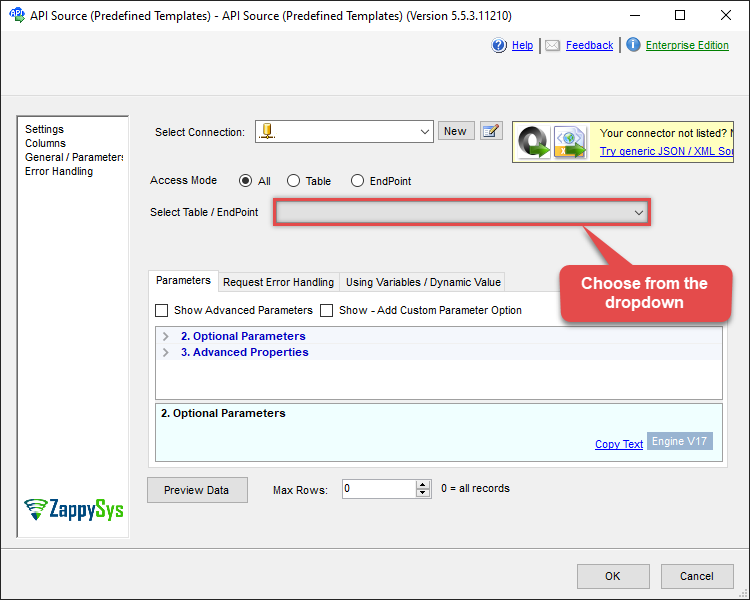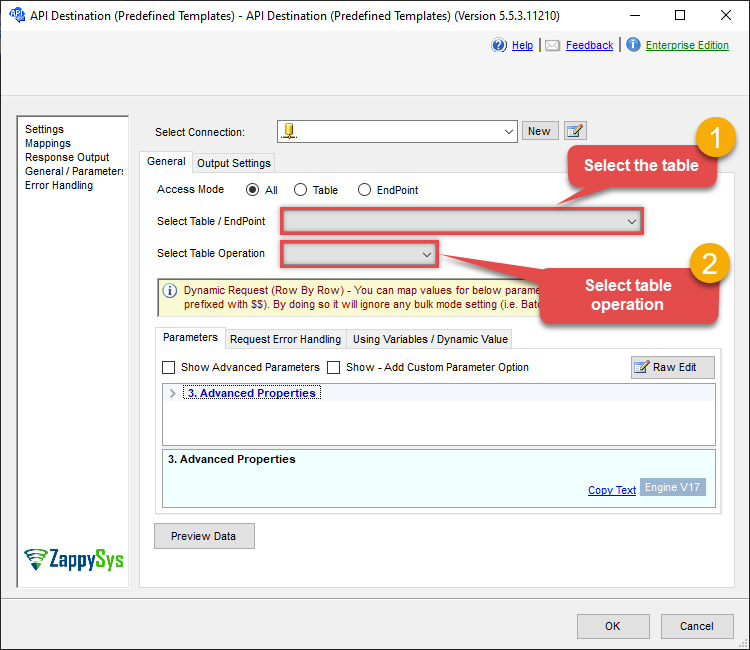Endpoint Upload a file
Name
upload_file
Description
Uploads a file. If file exits it does not overwrite. If you like to overwrite existing file then use [Replace file data] endpoint. It requires FileId you like to replace. Get file id by calling list_parent_items or list_files endpoint (Search for file name and get id). Google API does not allow to perform create or replace in one operation. [API reference]
Related Tables
Parameters
| Parameter | Required | Options | ||||||
|---|---|---|---|---|---|---|---|---|
|
Name:
Label: Target FileName A filename the file will have in Google Drive |
YES | |||||||
|
Name:
Label: Local FilePath Specify a disk file path |
YES | |||||||
|
Name:
Label: Keep Revision Forever Defines whether uploaded file has revisions |
|
|||||||
|
Name:
Label: Parent FolderId Id of a parent folder you want to upload the file in. Use value 'root' to place the file in the topmost level. |
||||||||
|
Name:
Label: Shared DriveId By default file lists from MyDrive but if you like to search other Shared drive then set this parameter. |
||||||||
|
Name:
Label: Drive Type Default search context is User's drive. Bodies of items (files/documents) to which the query applies. Supported bodies are 'user', 'domain', 'drive', and 'allDrives'. Prefer 'user' or 'drive' to 'allDrives' for efficiency. By default, corpora is set to 'user'. However, this can change depending on the filter set through the 'Query' parameter. |
|
|||||||
|
Name:
Label: Supports all drives (e.g. My and Shared) Whether the requesting application supports both My Drives and shared drives. |
|
|||||||
|
Name:
Label: AddParents A comma-separated list of parent IDs to add |
||||||||
|
Name:
Label: OcrLanguage A language hint for OCR processing during image import (ISO 639-1 code). |
||||||||
|
Name:
Label: UseContentAsIndexableText Whether to use the uploaded content as indexable text. |
Output Columns
| Label | Data Type (SSIS) | Data Type (SQL) | Length | Description |
|---|---|---|---|---|
| Id |
DT_WSTR
|
nvarchar(440)
|
440 | |
| Kind |
DT_WSTR
|
nvarchar(200)
|
200 | |
| Name |
DT_WSTR
|
nvarchar(780)
|
780 | |
| MimeType |
DT_WSTR
|
nvarchar(650)
|
650 | |
| FileSize |
DT_I8
|
bigint
|
||
| DriveId |
DT_WSTR
|
nvarchar(4000)
|
4000 |
Input Columns
| Label | Data Type (SSIS) | Data Type (SQL) | Length | Description | |||||||||||||||||||||||||||||||||||||||||||||||||||||||||||||||||||||||||||||||||||||||||||||||
|---|---|---|---|---|---|---|---|---|---|---|---|---|---|---|---|---|---|---|---|---|---|---|---|---|---|---|---|---|---|---|---|---|---|---|---|---|---|---|---|---|---|---|---|---|---|---|---|---|---|---|---|---|---|---|---|---|---|---|---|---|---|---|---|---|---|---|---|---|---|---|---|---|---|---|---|---|---|---|---|---|---|---|---|---|---|---|---|---|---|---|---|---|---|---|---|---|---|---|---|
| There are no Static columns defined for this endpoint. This endpoint detects columns dynamically at runtime. | |||||||||||||||||||||||||||||||||||||||||||||||||||||||||||||||||||||||||||||||||||||||||||||||||||
Examples
SSIS
Use Google Drive Connector in API Source or in API Destination SSIS Data Flow components to read or write data.
API Source
| Required Parameters | |
|---|---|
| Target FileName | Fill-in the parameter... |
| Local FilePath | Fill-in the parameter... |
| Optional Parameters | |
| Keep Revision Forever | |
| Parent FolderId | root |
| Shared DriveId | |
| Drive Type | user |
| Supports all drives (e.g. My and Shared) | true |
| RawOutputDataRowTemplate | {Status:'Uploaded'} |
| EnableRawOutputModeSingleRow | True |
| AddParents | |
| OcrLanguage | |
| UseContentAsIndexableText | False |

API Destination
This Endpoint belongs to the Files table, therefore it is better to use it, instead of accessing the endpoint directly. Use this table and table-operation pair to upload a file:
| Required Parameters | |
|---|---|
| Target FileName | Fill-in the parameter... |
| Local FilePath | Fill-in the parameter... |
| Optional Parameters | |
| Keep Revision Forever | |
| Parent FolderId | root |
| Shared DriveId | |
| Drive Type | user |
| Supports all drives (e.g. My and Shared) | true |
| RawOutputDataRowTemplate | {Status:'Uploaded'} |
| EnableRawOutputModeSingleRow | True |
| AddParents | |
| OcrLanguage | |
| UseContentAsIndexableText | False |

ODBC application
Use these SQL queries in your ODBC application data source:
Upload a file with INSERT keyword
Upload a file with INSERT keyword. Advantage of INSERT is you can use Bulk option using SOURCE clause. This way you can upload many files
INSERT INTO Files
WITH (FileName='My filename'
,DiskFilePath='C:\MyFolder\Mymyfile.ext'
,ParentFolderId='root'
)
--You can get ParentFolderId by selecting from 'list_folders' endpoint or just use 'root'
upload_file endpoint belongs to
Files
table(s), and can therefore be used via those table(s).
SQL Server
Use these SQL queries in SQL Server after you create a data source in Data Gateway:
Upload a file with INSERT keyword
Upload a file with INSERT keyword. Advantage of INSERT is you can use Bulk option using SOURCE clause. This way you can upload many files
DECLARE @MyQuery NVARCHAR(MAX) = 'INSERT INTO Files
WITH (FileName=''My filename''
,DiskFilePath=''C:\MyFolder\Mymyfile.ext''
,ParentFolderId=''root''
)
--You can get ParentFolderId by selecting from ''list_folders'' endpoint or just use ''root''';
EXEC (@MyQuery) AT [LS_TO_GOOGLE_DRIVE_IN_GATEWAY];
upload_file endpoint belongs to
Files
table(s), and can therefore be used via those table(s).
